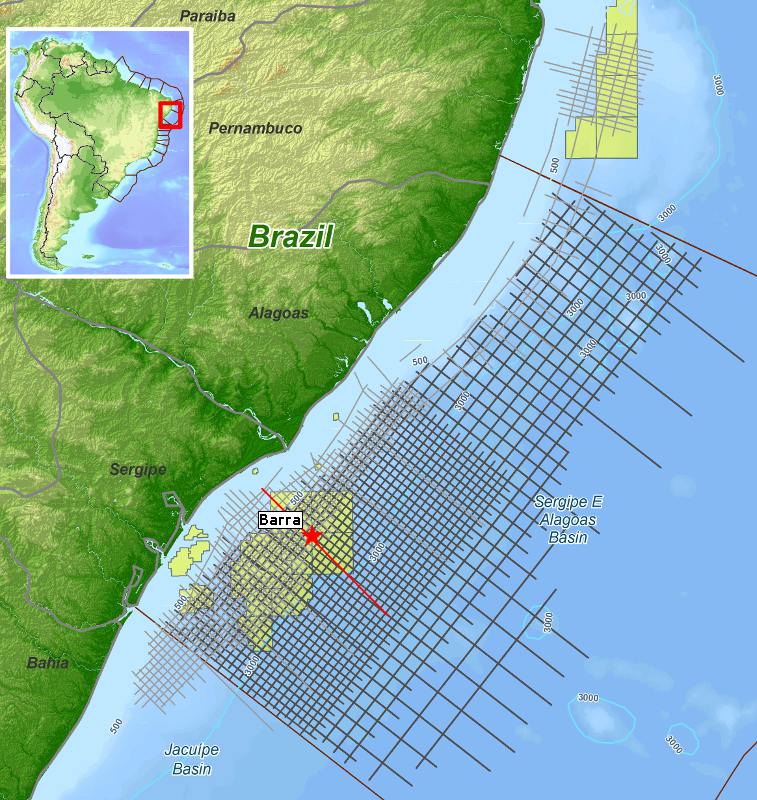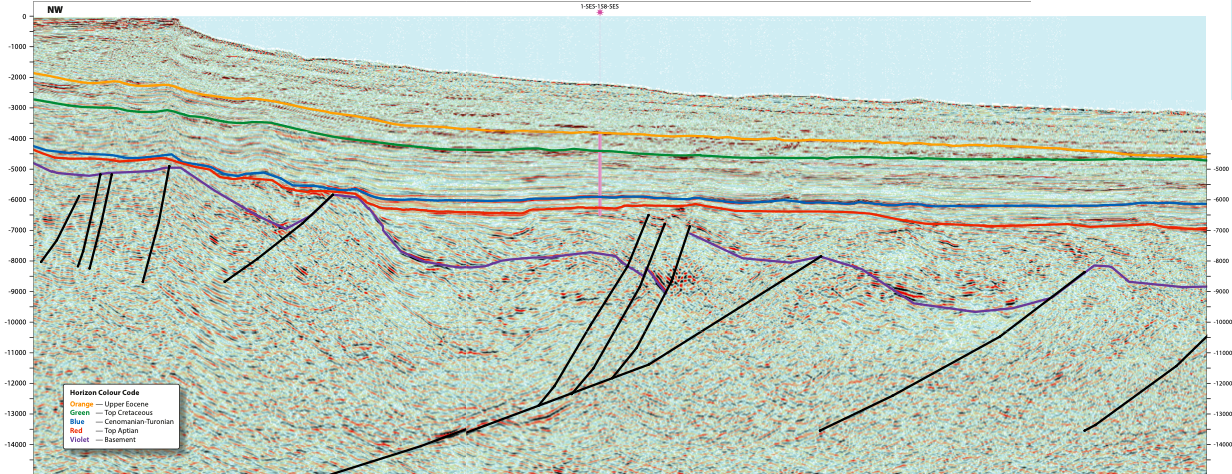
AVO signatures help identify hydrocarbons
Spectrum re-processed 8,200 km of seismic data in 2013, using modern pre-stack time and depth imaging algorithms. The 2D seismic data was acquired with an 8 km streamer in 1999, providing a wide range of reflection angles for quantitative interpretation. The re-processing illustrates clear images of stratigraphic features within the prospective section, and numerous potential AVO anomalies are evident. Two profiles near the 1-SES-158 Barra discovery well were selected and the digital logs from this well were incorporated into the analysis.
The Barra discovery well was drilled in September 2010, reaching a depth of 6,510m in 2,341m of water. Permeability and porosity conditions in the reservoir are excellent between 4,650m and 4,750m, where drill stem tests indicate gas and condensate are present in commercial quantities. The sandstones encountered in the Barra well are approximately 80m thick, and well tests indicate a high porosity gas-charged reservoir.
AVO attributes
For mid to high porosity sandstones encased in shales or mudstones, gas and light oil saturated sandstones can be identified using amplitude versus offset (AVO) techniques with high-quality, long-offset seismic data.
Examination of available well data shows that the sandstone in the Barra well does have 25% to 33% porosities, with velocities that are equivalent to or slightly faster than shale velocities and sand densities that are less than the shale densities. AVO modelling indicates a Class 2 to Class 3 AVO response depending on the thickness of the sand modelled. AVO attributes computed from the models indicate that the enhanced gradient (FNxF) and scaled Poisson’s ratio change (SPR) attributes should be diagnostic for sands of sufficient thickness.
SPR change is the weighted sum of the AVO intercept and gradient, where the weighting is determined by the background Vp/Vs ratio of the geology. The SPR attribute is a fluid factor AVO attribute that should illuminate hydrocarbon-saturated reservoirs and marginalise wet or brine-saturated reservoirs. The FNxF attribute is computed by calculating the difference between the far angle stack and the near angle stack, and multiplying the difference by the far angle stack. Angle ranges are used in place of offset ranges so they are optimised for the geology and objective depth.
For the purpose of determining whether AVO attribute stacks can identify potential hydrocarbon reservoirs, we look at 2D seismic profiles that tie the Barra discovery well. For each of these profiles we compute an SPR and FNxF stack, both of which should show visible anomalies for the high porosity, gas-saturated sands found in the Barra discovery well.
Pre-stack depth migrated section through the Barra discovery well
Amplitude variation with offset (AVO) techniques are valuable tools that assist exploration, development and production teams to identify hydrocarbons in clastic depositional settings. The clastic reservoirs in the Sergipe Basin offshore Brazil are well suited for quantitative interpretation, best illustrated by the classic bright spot which can be observed on the seismic section below, at a depth of 4,700m near the well bore.
The recent announcement by the Brazilian energy regulatory agency ANP that the Sergipe Basin is to be included in Round 13 indicates that there is considerable opportunity for additional prospecting in this basin. AVO techniques will prove to be important both for prospecting and for reducing drilling risk as the exploration cycle expands and progresses to development in the Sergipe Basin.
Seismic examples
Line 21 is a strike line near the Barra 1 well. The first panel in the figure below shows the full stack in wiggle trace and the SPR change attribute in variable area. For a hydrocarbon-saturated reservoir the SPR attribute should show a minimum at the top of the reservoir signifying a relative decrease in Poisson’s ratio (a decrease in Vp/Vs), and a positive SPR amplitude at the base of the reservoir assuming sufficient thickness to isolate the top and base of the sand. The event and overlaying attribute on the profile are quite similar to what has been described, with a strong negative SPR amplitude corresponding to the trough on the migrated stack amplitude and the positive blue-yellow SPR amplitude underlying the full stack peak.
In the second panel in the figure below this up-dip anomaly has the paired peak-peak character on the FNxF attribute, which typically corresponds to hydrocarbon-saturated reservoirs. This display also presents the known hydrocarbon-saturated reservoir with a single peak over a weak mix of positive and negative FNxF responses. The lack of a double peak in this instance might be attributed to the multi-legged nature of the event (a more complex sand body) and interference effects that may be negating the increase in amplitude versus offset on the base of the sand or other subjacent sands.
Hydrocarbon charge identified
Based on the available well data and the 2D profiles covering this basin, AVO anomalies from SPR and FNxF attributes can identify hydrocarbon charge in sandstone reservoirs, for thick sands with 18% or higher porosity. This screening process will not necessarily eliminate other geologies with lower Vp/Vs ratios: it will, however, highlight prospective anomalies and cull out leads and prospects that do not exhibit AVO signatures associated with hydrocarbons.







